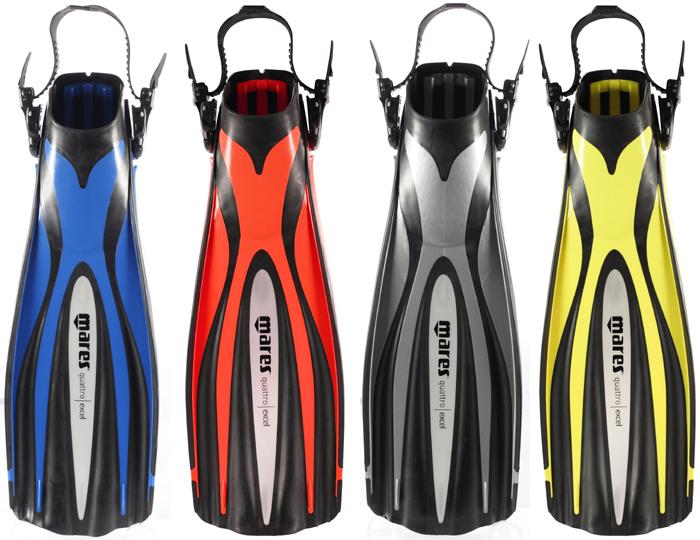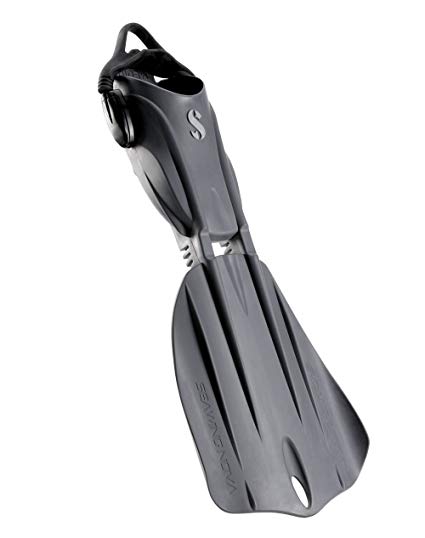OTHER FEATURES OF FINS
In addition to the attributes mentioned, there are other aspects of fins that also go into a purchase decision.
The first of these is whether you want a Full Foot fin or an Open Heel fin – the former are meant to be worn on bare feet, whereas the latter require the diver to wear booties (or at the very least, neoprene socks). The benefit of full foot fins is that they can be very comfortable and feel very secure – and also require one less piece of equipment. On the flip side, fit is very important – if the foot pocket doesn’t match your foot shape and is too loose or tight, it can hurt or result in blisters. Open heel fins are more flexible in terms of fit, and also allow you the ability to wear the fins over a broader range of water temperatures. Plus, if you are doing shore dives, dive booties are very nice to have – especially on rocky water entries.
Another point to consider is fin size and weight – in this day and age of ever-miserly baggage allowances, large fins can be harder to travel with. I am always on the quest for smaller and more compact fins – but so far, I have yet to find one where the smaller size comes with no compromises (there are a couple of fins where the compromise can be acceptable in some conditions – but not universally so). And given the cost of a diving trip, the slight increase in inconvenience of taking the Right Fins is significantly outweighed by increased comfort when diving. Your mileage may vary, of course.
The last item is what I call “high tech features”: fancy designs meant to shift the thrust-to-effort ratio. These include gears to adjust stiffness, split fins, funky designs, etc. I have tried a bunch of them, and honestly, been underwhelmed – however, I also admit that while I like playing with new tech, it also takes convincing to get me to give up what has worked well in favor of the latest-and-greatest: especially when this latest-and-greatest often comes at a much higher cost. As with most things, personal preferences come into play. Personally, instead of just looking at the technology, I would evaluate fins like this using the 5 attributes I had mentioned earlier – ultimately, that is what matters, and not how “funky” the fins are. Obviously, if all else is equal, you can always choose to get the fins that are more high-tech: nothing wrong with wanting cool tech.
SELECTING THE RIGHT SET OF FINS FOR YOU
So now that you have read all of this, how do you actually select the correct fins for you?
Unfortunately, there is no clear answer to this. Because we all vary in our dive skills, personal fitness, swimming skills, buoyancy characteristics and kicking style, what works for me will not necessarily work for you – and by the same token. a set of fins that I discount may very well be the best fins ever for you.
The only way to find the right set of fins is to try out as many pairs as possible. The next time you go diving, try out a few different fins, if you can. Note the model and try to evaluate how they feel in terms of thrust, beat rate, stiffness, buoyancy and bite. Make a note of what you like about it and what you don’t (sometimes, you may have to try more than one set of fins before you start noticing these differences). You will note that some fins feel a lot better and improve your comfort in the water drastically – if possible, try to identify what particular aspect of those fins is contributing to this.
To help people with this process, we have also put together a basket of Recommended Fins – these are available to try out in our dive centers in the Andamans, as well as at our @Home dive centers in Delhi, Bombay, Bangalore and Chennai. We have selected fins that, from experience, have worked well for most divers – each of these fins are slightly different from the other in terms of attributes, and we feel confident that most divers will be able to find something that works for them from this set.
Contact us to set up an appointment to try this out!






